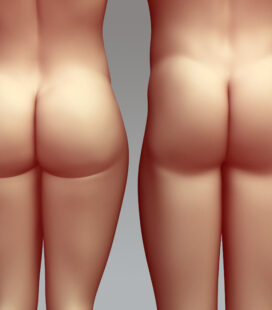Well, being in Brazil for part of my training, I have had many opportunities to “study” the famous Brazilian buttocks — that is, on the sun-drenched sandy beaches!
Why not?
So what’s so special about the Brazilian buttocks, one might ask?
Brazil became a great nation with the help of by many cultures, which included natives, Portuguese, Spanish, Italians, Jews, Japanese, and Arabs. But the famous buttocks likely come from the African slaves, who arrived in Brazil during the 16th, 17th, and 18th centuries — about 4 million total — to work on the sugarcane and coffee plantations and in the diamond and gold mines.
African men and women are known for their larger athletic muscles and rounder figures. Although slavery was abolished in 1888, the influence from the African culture has remained very present and vibrant in Brazil, from its music and its flavourful and colourful food to, of course, the Brazilian buttocks.
It also helped that one of the first televised Brazilian Butt Lift performed in the USA was on an americanized Brazilian lady… and from that TV episode, the term Brazilian Butt Lift was born.
So much so that the name “Brazilian butt lift” stuck with my Toronto patients. “Curves are back in Toronto,” as I commonly say, and it is even more true for our Latin, African, and Southern American patients. Fuller outer thighs and buttocks are now praised, not only by our patients, but also by all those men who love them!
So I’ve just established that a fuller buttock is a strong trend in my Toronto practice and in Canada generally, and I truly believe it is here to stay for a long time! Jennifer Lopez, Kim Kardashian, Serena Williams, Shakira, etc. are all living proof.
That applies to men as well! You just have to look at all those soccer players. No man looks good with a flat butt. Men do seek buttock augmentation as well in my practice. My technique for buttock augmentation in men is slightly different — see my previous blog post for more details; we aim for a “bubble butt” with more posterior projection (think Ricky Martin) as opposed to posterior and lateral (side) projection as desired for a woman.
So what is the Brazilian Butt Lift, or BBL, as it is commonly known?
The Brazilian butt lift is a take on fat grafting or fat transfer. As many now know, fat transfer techniques have been popularized and refined by Dr. S. Coleman from New York City.
The so-called Brazilian butt lift consists of fat transfer from other parts of the body to the buttock regions. This uses the patient’s own fat tissue, and a significant amount of fat from the patient is required in order to increase the buttock region significantly.
Fat grafting is a delicate procedure, in which we hope that most of the fat survives. I do use the best technique: The Coleman’s technique involves the use of tumescence solution infiltration. There’s a gentle low-pressure fat harvesting, cleaning and decanting of the fat, centrifugation of the fat, transfer of fat and stem cells into smaller cannulas, and finally, a very meticulous and tedious transfer of fat, in the multiple layers of each buttock.
Anything too fast and too careless will lead to large lumps, oil cysts, and a poor fat survival. All this requires a significant amount of surgical time, hence the cost of the procedure.
There is a limit to how much fat can be infiltrated in one buttock in one setting; beyond that number, the transferred fat “suffocates” under the pressure and will die.
There is always a percentage of fat cells that will not survive (~30-50%) despite the best surgical and artistic hands and the best techniques. Depending on how much fat assimilates in its new location, patients may require a second fat grafting procedure 6 to 12 months later. It takes 3 months to get the final result of fat grafting to buttocks, so any earlier pictures would be misleading. Beware of any “after” pictures where bruises are still visible! Everything looks good when swollen.
Where does the fat come from?
For the Brazilian butt lift, the fat is often harvested from many regions: the abdomen, the hips, the thighs, the legs, the back rolls and the inner knees, for example. We need to harvest a lot of fat, as we do lose some during the cleaning and centrifugation process, in addition to the normal physiology of fat survival with fat grafting.
The liposuction performed for fat grafting is at a low-pressure setting in order to minimize the mechanical destruction of fat cells. That means the liposuction part takes a considerable amount of time to be done correctly.
If someone expects a slimming liposuction result at the donor sites, and it is a very reasonable expectation in my practice, I first harvest gently and delicately the required amount of fat for the fat transfer, and only after that will I proceed with the traditional higher suction pressure to complete the liposuction results. I also apply the principles of SAFELipo® liposuction.
Other Details
The other option for a buttock augmentation would be a buttock implant, which is a very reliable augmentation, or a combination of implants and fat grafting. We have a several options of shapes and sizes in Canada. See my other blogs on buttock implants.
Recovery after Brazilian butt lift surgery is similar to buttock implants. In either case, sitting is not recommended for the first 2 or 3 weeks (other than to use the bathroom) in order to minimize pressure and movement on the freshly transferred fat cells.
Cost also varies depending on how many areas and how many different positions are required for the harvesting (e.g., lying flat on tummy, lying flat on the back, etc.). These will all affect the amount of required anesthesia time, which contributes to the cost.
Hope this blog has been educational!
By Dr. Marc DuPéré



















